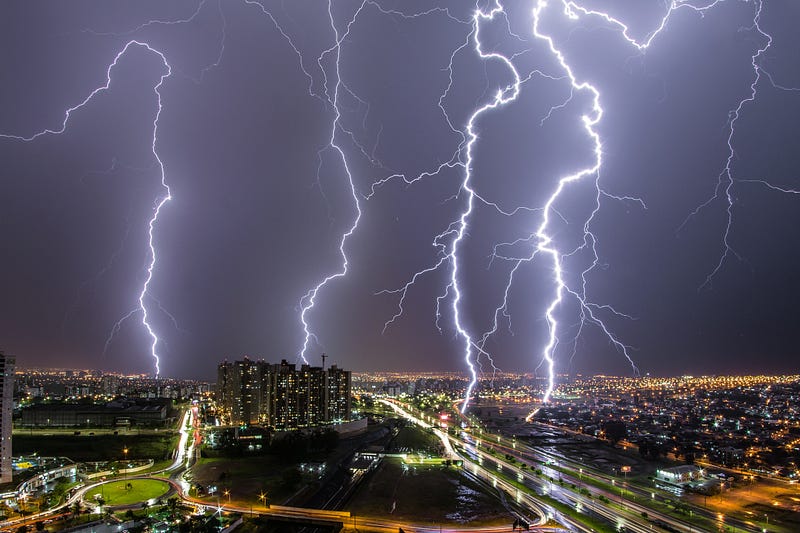Understanding the New Era of Lightning Events: A Global Perspective
Written on
Chapter 1: The Emergence of Lightning Sieges
In recent years, we've encountered a variety of extreme weather phenomena that were once unknown to many. Terms like "firenadoes," "heat domes," "rain bombs," and "pyrocumulonimbus clouds" have entered our vocabulary. Now, we can also add "lightning siege" to that list.
Different regions experience distinct types of extreme weather, including hurricanes, floods, wildfires, and droughts. However, lightning is unique in that it can occur almost anywhere. On average, the Earth experiences lightning strikes approximately 100 times every second. But this statistic is changing as our oceans heat up, absorbing energy equivalent to seven Hiroshima bombs every second. Just a slight increase in temperature has led to a 12% rise in lightning strikes. Similar to other consequences of climate change, we are witnessing a trend of intensifying lightning events that far exceed anything seen in movies.
Lightning has always intrigued me. My sister once gifted me a fulgurite— a glassy tube formed by lightning striking sand— which I display proudly. When dark clouds gather, I instinctively reach for my rain gear. I've even been within ten meters of a lightning strike, which can heat the air to a staggering 10,000ºC (50,000ºF), hotter than the sun’s surface at impact. This intense heat causes the surrounding air to explosively expand, resulting in thunder that can be heard from up to 40 km (25 miles) away. However, the sheer volume of rapid lightning strikes poses a whole new level of danger.
Each year, lightning claims the lives of people, livestock, and wildlife, while causing billions in damages to infrastructure, communication systems, and electrical equipment. The aviation industry incurs massive financial losses due to flight rerouting and delays caused by lightning.
Thanks to advancements in satellite technology, we can now track and visualize lightning strikes in real-time, allowing us to count them as they occur. Notably intense lightning events are becoming more frequent.
In August 2020, California was astounded by 12,000 lightning strikes in just one week, a result of tropical storm Fausto and hurricane Genevieve. Similarly, a 200-kilometer area in Andhra Pradesh, India, experienced a staggering 36,000 lightning strikes in a mere 13 hours at the onset of monsoon season.
However, it’s the megafires that truly escalate the situation. These massive fires can generate their own storm clouds, unleashing further fires through dry lightning. In July 2021, an area was bombarded with over 700,000 lightning strikes in a single day.
We understand that the increasing energy from tropical storms leads to more static electricity in clouds, which manifests as lightning. As we witness larger floods and wildfires, these patterns are not surprising. Nevertheless, climate chaos often brings unexpected challenges—wild cards that can make predicting risks much more complicated.
Historically, the Arctic has been a region with very few lightning strikes, yet in 2021, the number surged dramatically, reaching double the total of the previous nine years combined. The implications of this sudden increase remain uncertain, raising concerns among scientists about the unpredictability of such risks. We are left to wonder whether other unusual weather phenomena will become more prevalent in the future.
One fact remains indisputable: As long as humanity continues to invest an astonishing eleven million dollars every minute in fossil fuel subsidies, we are far from seeing the worst of it.
This article is brought to you by Medium, where diverse writers share their insights. By being a member, you support the writers you enjoy and gain full access to their stories.
Section 1.1: Lightning and Climate Change
In this section, we explore how climate change is influencing lightning activity and its global implications.
Subsection 1.1.1: The Science Behind Lightning Events

Section 1.2: Tracking Lightning Strikes
The advancements in satellite technology have revolutionized how we monitor lightning events.
Chapter 2: The Impact of Lightning Sieges on Nature and Humanity
This video showcases the dramatic lightning strikes in Central California, where a staggering 6,000 strikes occurred within a short timeframe.
This video features staggering footage of a lightning storm that ignited multiple fire complexes in the Bay Area, highlighting the dangers posed by such extreme weather.